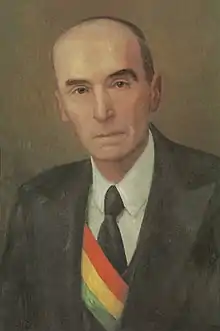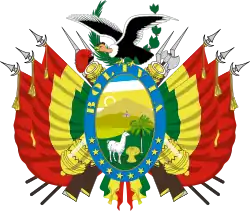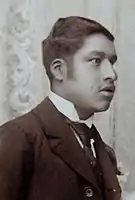Cabinet of Néstor Guillén
Néstor Guillén assumed office as the interim 40th President of Bolivia on 21 July 1946, and his mandate ended on 17 August 1946. A magistrate of the Superior District Court of La Paz, Guillén was chosen to lead an interim junta in the absence of the President of the District Court Tomás Monje, who was ill at the time, in the wake of the violent demise of President Gualberto Villarroel.
Guillén cabinet | |
|---|---|
112th Cabinet of the Republic of Bolivia | |
| 1946 | |
 | |
| Date formed | 21 July 1946 |
| Date dissolved | 17 August 1946 |
| People and organisations | |
| President | Néstor Guillén |
| Vice President | Vacant |
| No. of ministers | 6 (on 17 August 1946) |
| Member party | Caretaker government |
| History | |
| Predecessor | Cabinet of Gualberto Villarroel |
| Successor | Cabinet of Tomás Monje (interim) |
 |
|---|
|
|
Guillén formed one cabinet three days after taking office, constituting the 112th national cabinet of Bolivia as part of the 1946–1947 Government Junta.[1]
Cabinet Ministers
Cabinet of Bolivia Interim Presidency of Néstor Guillén, 1946 | |||||||||
|---|---|---|---|---|---|---|---|---|---|
| Office | Minister | Party | Prof. | Term | Days | N.C[lower-alpha 1] | P.C[lower-alpha 2] | ||
| President | Néstor Guillén | Ind. | Law. | 21 July 1946 – 17 August 1946 | 27 | – | – | ||
| Vice President | Office vacant throughout presidency | ||||||||
| Secretary-General of the Junta | Office blank 21 July 1946 – 6 August 1946 | ||||||||
| Roberto Bilbao la Vieja[2] | – | Law. | 6 August 1946 – 10 March 1947 | 216 | 112 | 1[lower-alpha 3] | |||
| Minister of Foreign Affairs and Worship (Chancellor) |
Minister of Education and Indigenous Affairs |
Aniceto Solares[3] | PRG | Dip. | 24 July 1946 – 7 March 1947 | 226 | 112 | 1[lower-alpha 3] | |
| Minister of Government and Justice |
Minister of Public Works and Communications |
Cleto Cabrera García | – | Mag. | 24 July 1946 – 26 August 1946 | 33 | 112 | 1 | |
| Minister of National Defense | Minister of Agriculture, Livestock, and Colonization |
Néstor Guillén | Ind. | Law. | 24 July 1946 – 26 August 1946 | 33 | 112 | 1 | |
| Minister of Finance, Statistics, and Economy |
Luis Gosalvez Indaburu | – | – | 24 July 1946 – 26 August 1946 | 33 | 112 | 1 | ||
| Minister of Work, Health, and Social Security |
Aurelio Alcoba | PIR | Uni. | 24 July 1946 – 10 March 1947 | 229 | 112 | 1[lower-alpha 3] | ||
Composition
On 24 July 1946, the civil junta which made up Néstor Guillén's cabinet was expanded to include representatives from the labor, student, and magistrate sectors. Minister of Finance Luis Gosalvez Indaburu, a partner in the law firm employed by Moritz Hochschild, would represent the universities while Foreign Minister Aniceto Solares would represent the teachers.[4][5] Aurelio Alcoba, the Secretary-General of the Trade Union Confederation of Bolivian Workers, was appointed Minister of Work and Social Security as the representative of the worker's unions.[4] Roberto Bilbao la Vieja, employed by the Asociacion de Industriales Mineros (Association of Mining Industrialists, a legal entity of the three tin magnates), was made Secretary-General.[1]
Many of the members of the junta held multiple cabinet positions, including Guillén himself who in addition to being president was Minister of Defense and Minister of Agriculture.[1] On 17 August, Tomás Monje assumed command of the junta. All of the members of Guillén's cabinet remained in office until Monje appointed his own ministers on 26 August. Alcoba, Solares, and Bilbao la Vieja would remain in their positions until the end of Monje's mandate.
Gallery
Notes
- Denoting which national cabinet the minister was originally a part of.
- Denoting which presidential cabinet the minister was originally a part of.
- Held over into the Monje cabinet.
References
- Gisbert 2003, pp. 346–347.
- "canciller". 6 December 2015. Archived from the original on 6 December 2015. Retrieved 9 February 2021.
- "canciller". archive.vn. 19 February 2013. Archived from the original on 19 February 2013. Retrieved 17 February 2021.
- "Diary of a Successful Revolution" (PDF). The Foreign Service Journal: 56. 21 July 1946.
- Kohl, James (26 November 2020). Indigenous Struggle and the Bolivian National Revolution: Land and Liberty!. Routledge. ISBN 978-1-000-21005-7.
Bibliography
- Gisbert, Carlos D. Mesa (2003). Presidentes de Bolivia: entre urnas y fusiles : el poder ejecutivo, los ministros de estado (in Spanish). Editorial Gisbert.

